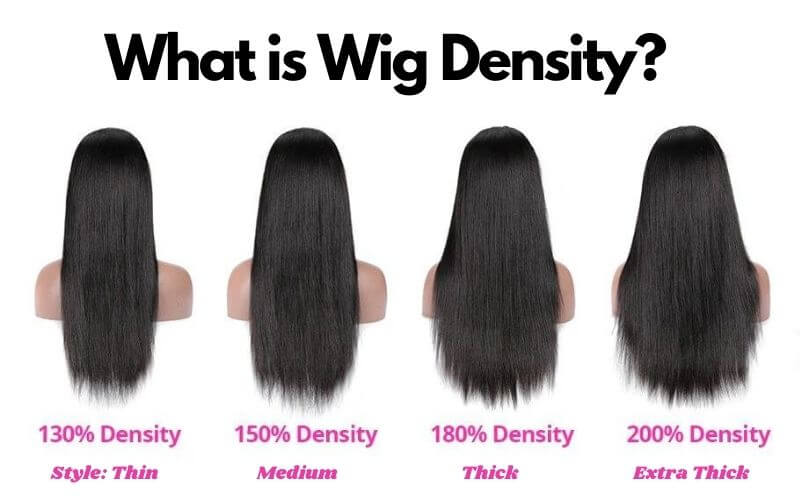Wig density plays a pivotal role in achieving a flawless, natural look with your wig. But what is wig density? and how do you find the right one for you? In this comprehensive guide, we delve into the world of wig density, explaining what it means, how to determine the right density for you, and the factors that influence this crucial choice.
What is wig density?
What does density mean in wigs? Wig density refers to the amount of hair fibers or strands that are present on a wig’s cap. It is typically expressed as a percentage and indicates how full or thick the wig appears. The higher the wig density percentage, the more hair the wig contains, making it look fuller and denser. Conversely, lower wig density percentages mean the wig will appear thinner and less voluminous.

Wig density is a critical factor when selecting a wig, as it affects the overall look and style. The choice of wig density should be based on personal preferences, desired hairstyle, and the natural look you want to achieve. Common wig density percentages range from extra light (around 60%) to extra heavy (approximately 180%). A medium density wig, around 120%, is often chosen as it closely mimics the density of the average human head and provides a natural appearance.
It’s important to note that wig density does not refer to the texture or thickness of each individual hair strand but rather the overall appearance of the wig. Some wigs may have thick individual strands or thin ones, but the density percentage indicates the overall fullness or thickness of the wig as a whole.
Why Density important?
If you’ve ever doubted the significance of wig density, it’s time for a revelation – it matters, and it matters a lot!
Opting for a wig with a density that mirrors your natural hair ensures that your secret remains well-hidden, and observers see only your fabulous locks. Moreover, it ensures a comfortable fit without causing any discomfort or harm to your scalp.
Let’s delve into four compelling reasons why you should give due consideration to hair density when embarking on your wig-buying journey.

- Natural Look and Comfort: Matching wig density to your natural hair makes your wig look more natural and feels comfortable on your scalp.
- Haircare: Different densities may need different hair care products. Knowing your wig’s density helps you care for it properly.
- Price: High-density wigs cost more than low-density ones. Understanding density options helps you find the right balance between quality and your budget.
- Styling Choices: Wig density affects your styling options. Some hairstyles need a specific density to achieve the desired look.
How Wig Density is Classified

Wig density is commonly categorized through percentages or descriptive terms that convey the wig’s thickness or fullness. Percentage classification represents the amount of hair on the wig cap relative to the average human head, including categories like Extra low density, Low density, Medium Density and Heavy…. Alternatively, term classification uses descriptive terms like Natural, indicating a density close to the average human head (around 100% to 120%), or Full for wigs with higher density (around 150% to 180%). Thin or Light describes wigs with lower density, typically around 60% to 80%. These classification methods provide wig buyers with a clear way to choose a density that suits their desired look, style, comfort, and maintenance preferences.
Wig Density Chart
Wig densities come in a range of options to cater to diverse preferences and requirements. Here’s an overview of different wig density levels and their characteristics:
1. Extra low density wigs: 50% to 60%
These wigs feature the sparsest concentration of hair, making them ideal for achieving extremely natural-looking hairlines. They are suitable for individuals with very fine or thin hair, offering a subtle and realistic appearance.
2. Low density wig: 80% – 90%
Low-density wigs are lightweight and natural in appearance. They provide a delicate, subtle look that’s comfortable for everyday wear and are often used to create a seamless hairline.
3. Low to Medium Density: 100% – 110%
This density level offers a natural feel and appearance. Light at the hairline, it gradually transitions to medium density for a balanced, realistic look that closely resembles natural hair.
4. Medium Density: 120% to 130%

Medium-density wigs mimic the regular hair density found on an average human head. They provide a natural fullness that is neither too thick nor too thin, making them a popular choice.
5. Heavy density lace wigs : 140% to 150%
These wigs offer a fuller and more voluminous look compared to medium density. They are slightly heavier and provide versatility with bounce, movement, and various styling options.
6. Extra Heavy Density: 160%, 180% and 200 density wig
Reserved for special occasions or performances, these wigs are the heaviest and offer unique styling possibilities. They provide a dramatic and high-volume look, although they may be less comfortable for extended wear due to their weight.
How to choose density for wig ?
Choosing the right wig density involves taking various factors into account to ensure it aligns with your preferences and lifestyle.

- Hairstyle and Length: Choose wig density based on your preferred hairstyle and hair length. Longer styles and straight hair suit higher densities, while shorter styles and thicker textures work better with lower densities.
- Natural Hair: Match the wig’s density to your natural hair for a seamless look. Fine hair suits densities around 130-150%, while thicker hair benefits from 180-250% density wigs.
- Lifestyle: Consider your lifestyle; lower densities are cooler and better for active routines, while higher densities provide fullness for special occasions.
- Age: For a natural appearance, older individuals might prefer lower-density wigs as hair naturally thins with age.
- Hair Texture: Curly wigs need less density, while straight wigs benefit from higher densities for a fuller look.
- Material Quality: Opt for wigs made of 100% virgin or Remy human hair for the best overall appearance. High-quality materials enhance the wig’s realism.
What is the best density for a wig?
When it comes to choosing the best wig density, there isn’t a one-size-fits-all answer. The ideal density depends on the specific look you want to achieve. Here are some considerations to help you determine the most suitable wig density:
- Hairstyle: The hairstyle you desire plays a significant role in choosing the right density. Longer, straight styles typically require higher densities (around 150% or more) to appear full, while curly styles can maintain fullness with lower density. Additionally, consider if you plan to style the wig with heated tools, as this may influence your density choice.
- Lifestyle: Align your wig density with your lifestyle and events. If you want your hairstyle to match your signature look, select the density that suits different occasions. Higher density wigs are great for nights out, while lower density wigs are practical for activities like workouts.
- Natural Hair: To achieve a look that closely resembles your natural hair, opt for a wig density similar to your own. You can determine your natural hair density by measuring the circumference of your ponytail. If it measures under 3 inches, your hair is lighter; on the contrary if it exceeds 3 inches, it’s denser.
Frequently Asked Questions – Wig Density:
1. Hair Density VS Hair Thickness

Hair density refers to how many hair strands are present in a given area on the scalp. It’s usually measured as the number of hair follicles per square inch or centimeter of the scalp.
Hair thickness relates to the diameter or width of individual hair strands. Hair can be categorized as fine, medium, or coarse based on its thickness.
2. Recommendation Wig Density Regard to Length
There isn’t a strict rule, but some general guidelines can help. Longer wigs, especially straight styles, often benefit from higher densities (150% or more) to maintain a full look. Shorter wigs can achieve a natural appearance with lower densities. However, the choice ultimately depends on your desired style and personal preferences.
3. Where to buy low density wigs

You can find wigs with various densities, including lower densities, at hairbusiness.org . Be sure to check product descriptions and reviews to ensure you’re selecting a wig with the density you desire.
4. How is wig density measured
Wig density is typically measured as a percentage, representing the proportion of hair on the wig cap relative to the average human head. Common density percentages include Extra Light (around 60%), Light (around 80%), Medium (around 120%), and Heavy (around 180%). Some wigs may also be described using terms like Natural or Full to convey their density.
𝑭𝒐𝒓 𝒎𝒐𝒓𝒆 𝒊𝒏𝒇𝒐𝒓𝒎𝒂𝒕𝒊𝒐𝒏, 𝒄𝒐𝒏𝒕𝒂𝒄𝒕:
Whatsapp: +84898890054
Follow us on Instagram: @ownhumanhairbusiness and @lynhair.factory
Website: hairbusiness.org

